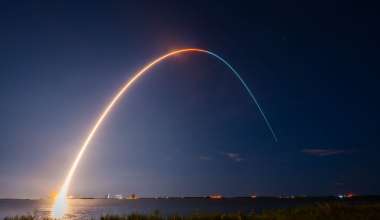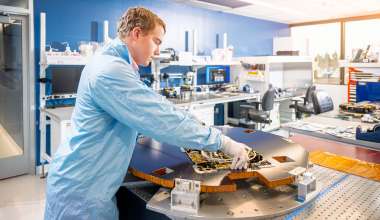The Near Infrared Airglow Camera (NIRAC) uses an Aerospace-patented orbital motion compensation system to take long-exposure, smear-free images at night. Motion compensation from a fast-moving, low Earth orbiting platform can be difficult, but NIRAC’s custom optical system enables imaging at a spatial resolution of 80 meters, even as the ISS travels more than 10 kilometers during the camera’s 1.5-second image exposure time.
Images are captured when no light is visible from the sun or moon by using airglow, which originates from a thin atmospheric layer near 85 kilometers in altitude, as a source of illumination. NIRAC’s Earth surface imagery covers a 160-kilometer-wide field of view every 10 seconds, producing detailed pictures of terrain features, city lights, clouds, roads, and lakes. Long exposure times enabled by its motion-compensation system further enhance NIRAC’s imaging capabilities over that of current polar-orbiting satellites.

(Right) Highlighted in the red square, NIRAC’s nighttime image of Wallops Island, Virginia, demonstrates its higher spatial resolution (x10) and sensitivity (x100) as compared to the VIIRS day-night band imagery. (Google map coordinates: 38 latitude and -75 longitude). Faint ripple-like variations seen across the image are waves in the airglow layer similar to ripples on a pond. Photo Credit: The Aerospace Corporation
“We’re using airglow as a natural flashlight for illumination and experimenting with an infrared wavelength band that isn’t typically used for nighttime Earth imagery,” said Dr. Lynette Gelinas, one of the principal investigators for NIRAC. “We will also use NIRAC to study airglow itself, as airglow brightness varies over the course of the night and responds to changes in lower-atmospheric weather.”
NIRAC employs a state-of-the-art focal plane array, similar to the one being flown on the James Webb Space Telescope, which provides the sensitivity needed to take full advantage of the novel optical system.
“NIRAC is a pathfinder for developing new instruments and applications,” said Gelinas. She notes the camera offers “a spaceflight demonstration of a highly capable, compact, and cooled infrared camera assembly.”
Aerospace scientists are already using these images to observe weather systems at night and explore potential applications related to disaster monitoring for fires, floods, and winter storms. Observations from NIRAC are enhancing scientists’ understanding of the Earth’s atmosphere near the edge of space, including the effects of atmospheric processes on space weather. NIRAC, which launched on May 4, 2019, as part of the Department of Defense Space Test Program, also has other space-based imagery applications, including astronomy.
Watch: The International Space Station Adds a Powerful New Camera
About The Aerospace Corporation
The Aerospace Corporation is a leading architect for the nation’s space programs, advancing capabilities that outpace threats to the country’s national security while nurturing innovative technologies to further a new era of space commercialization and exploration. Aerospace’s national workforce of more than 4,800 employees provides objective technical expertise and thought leadership to solve the hardest problems in space and assure mission success for space systems and space vehicles. For more information, visit www.aerospace.org. Follow us on LinkedIn and on X: @AerospaceCorp.




